Karl King was mentioned
in many pages of a 2021 Circus Fanfare
The January / February 2021 issue
published by Windjammers Unlimited Inc.
the Circus Music Historical
Society
Visit the website of Windjammers
Unlimited
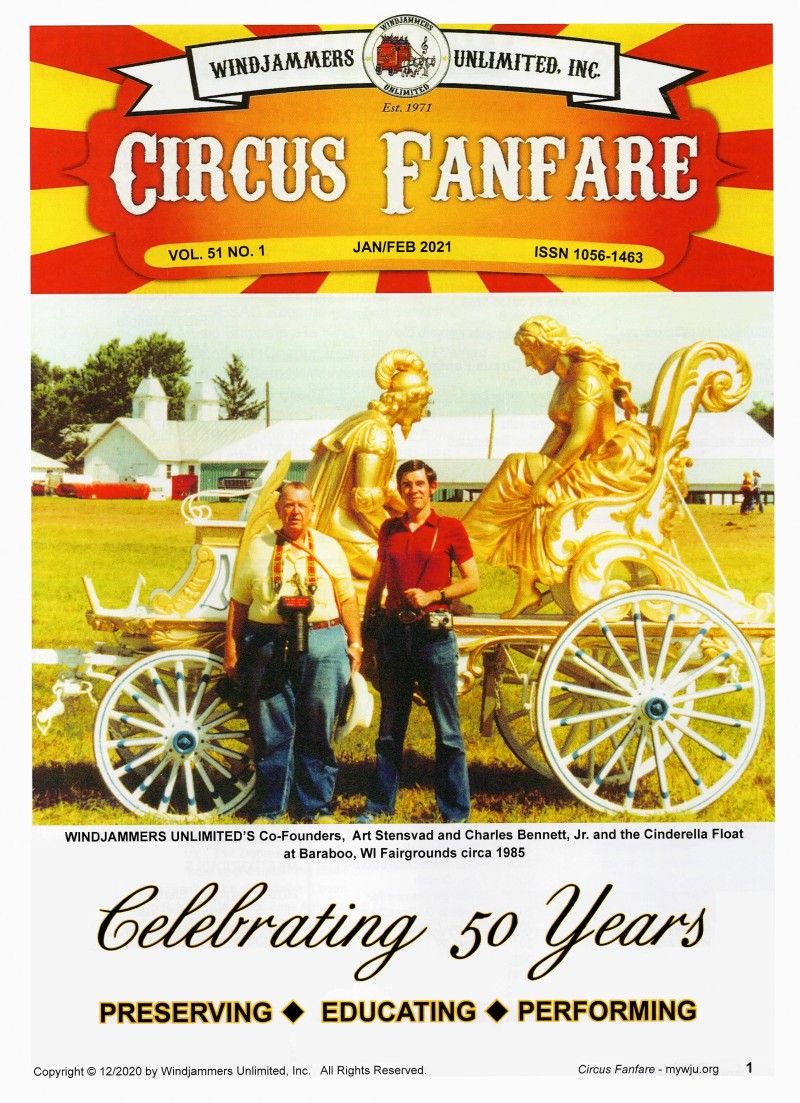
While this is not an attempt to duplicate this issue
of Windjammers Circus Fanfare,
the pages dealing with Karl King are seen on this
page and are used here with permission.
Jerrold Jimmerson, a member of
Windjammers Unlimited, provided much of the material on these pages.
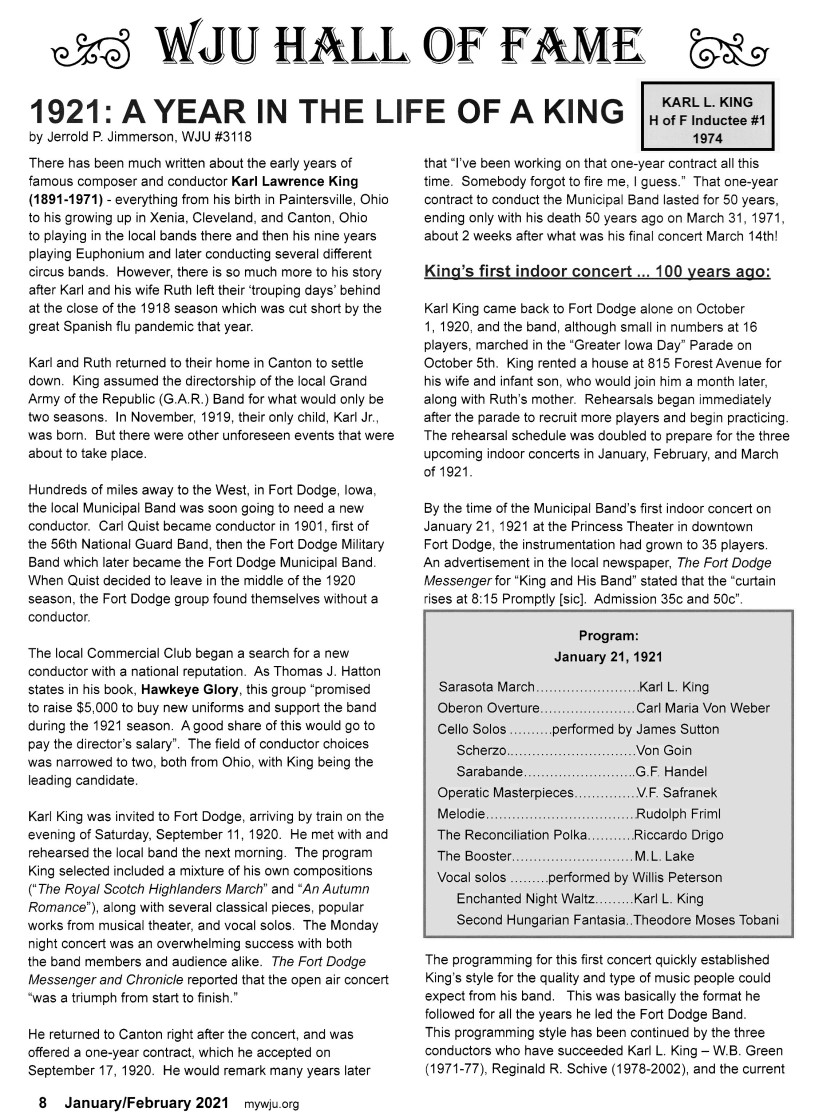
1921 - A YEAR IN THE LIFE OF
A KING:
by Jerrold P. Jimmerson, WJU
#3118
This article was originally published
in the January-February 2021 Circus Fanfare publication of Windjammers
Unlimited, Inc.: VOL. 51, NO. 1 - JAN/FEB 2021 - ISSN 1056-1463
There has been much written about
the early years of famous composer and conductor Karl Lawrence King (1891-1971)
- everything from his birth in Paintersville, Ohio to his growing up in
Xenia, Cleveland, and Canton, Ohio to playing in the local bands there
and then his nine years playing Euphonium and later conducting several
different circus bands. However, there is so much more to his
story after Karl and his wife Ruth left their ‘trouping days’ behind at
the close of the 1918 season, which was cut short by the great Spanish
flu pandemic that year.
Karl and Ruth returned to their
home in Canton to settle down. King assumed the directorship
of the local Grand Army of the Republic (G.A.R.) Band for what would only
be two seasons. In November, 1919, their only child, Karl Jr.,
was born. There were other unforeseen events, however, that
were about to take place.
Hundreds of miles away to the
West, in Fort Dodge, Iowa, the local Municipal Band was soon going to need
a new conductor. Carl Quist became conductor in 1901, first
of the 56th National Guard Band, then the Fort Dodge Military Band which
later became the Fort Dodge Municipal Band. When Quist decided
to leave in the middle of the 1920 season, the Fort Dodge group found themselves
without a conductor.
The local Commercial Club began
a search for a new conductor with a national reputation. As
Thomas J. Hatton states in his book, Hawkeye Glory, this group “promised
to raise $5,000 to buy new uniforms and support the band during the 1921
season. A good share of this would go to pay the director’s
salary”. The field of conductor choices was narrowed to two,
both from Ohio, with King being the leading candidate.
Karl King was invited to Fort
Dodge, arriving by train on the evening of Saturday, September 11th, 1920.
He met with and rehearsed the local band the next morning.
The program King selected included a mixture of his own compositions (“The
Royal Scotch Highlanders March” and “An Autumn Romance”), along with several
classical pieces, popular works from musical theater, and vocal solos.
The Monday night concert was an overwhelming success with both the band
members and audience alike. The Fort Dodge Messenger and Chronicle
reported that the open air concert “was a triumph from start to finish.”
He returned to Canton right after
the concert, and was offered a one-year contract, which he accepted on
September 17th 1920. He would remark many years later that “I’ve
been working on that one-year contract all this time. Somebody
forgot to fire me, I guess.” That one-year contract to conduct the
Municipal Band lasted for 50 years until his death on March 31, 1971, about
2 weeks after what was to become his final concert on March 14!
King’s first indoor concert:
Karl King came back to Fort Dodge
alone on October 1, 1920, and the band, although small in numbers at 16
players, marched in the “Greater Iowa Day” Parade on October 5th.
King rented a house at 815 Forest Avenue for his wife and infant son, who
would join him a month later, along with Ruth’s mother. Rehearsals
began immediately after the parade to recruit more players and begin practicing.
The rehearsal schedule was doubled to prepare for the three upcoming indoor
concerts in January, February, and March of 1921.
By the time of the Municipal
Band’s first indoor concert on January 21, 1921 at the Princess Theater
in downtown Fort Dodge, the instrumentation had grown to 35 players.
An advertisement in the local newspaper, The Fort Dodge Messenger for “King
and His Band” stated that the “curtain rises at 8:15 Promptly [sic].
Admission 35c and 50c”.
The programming for this first
concert quickly established King’s style for the quality and type of music
people could expect from his band. This was basically the format
he followed for all the years he led the Fort Dodge Band.
|
|
Program:
January 21, 1921
Sarasota March……………………………………………………………….Karl
L. King
Oberon Overture…………………………………………….…......Carl
Maria Von Weber
Cello Solos performed by
James Sutton
Scherzo…….Von Goin
Sarabande…G.F. Handel
Operatic Masterpieces……………………………………….………………V.F.
Safranek
Melodie…………………………………………………..………………...Rudolph
Friml
The Reconciliation Polka...………………………………..………………Riccardo
Drigo
The Booster……………………………………………….……………....Mayhew
L. Lake
Vocal solos performed by Willis
Peterson
Enchanted Night Waltz………………………………………………………Karl
L. King
Second Hungarian Fantasia………………………………………Theodore
Moses Tobani
|
|
This programming style has been
continued by the three conductors who have succeeded Karl L. King – W.B.
Green (1971-77), Reginald R. Schive (1978-2002), and the current conductor,
Jerrold P. Jimmerson (2003-present). All three of these persons
played under King’s baton for several years, and were heavily influenced
by his musical style.
It was a somewhat simple format.
Start with a march or two before going to a “heavy”, (an overture or transcription).
Follow that with a waltz or something lighter, then feature the soloist
of the day. After another march, the band would usually play
another “heavy” before moving on to some lighter selections – popular songs
of the day or from the Broadway stage, then a rag, a galop and other lighter
selections before the concluding march. Once the final note
of that march was played, it was time for the National Anthem.
All together, concerts would
last one hour, usually no more or no less. There were no encores.
King would always want to “leave the audience wanting more”.
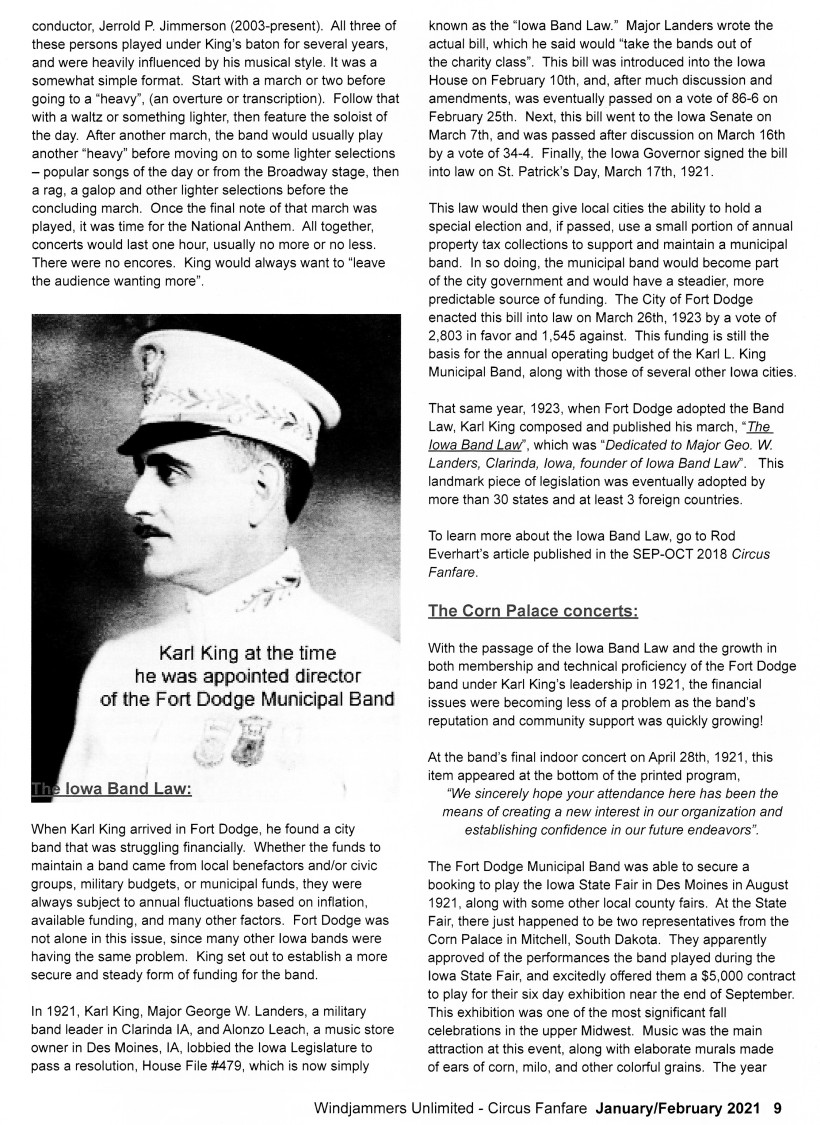
The Iowa Band Law:
When Karl King arrived in Fort
Dodge, he found a city band that was struggling financially.
Whether the funds to maintain a band came from local benefactors and/or
civic groups, military budgets, or municipal funds, they were always subject
to annual fluctuations based on inflation, available funding, and many
other factors. Fort Dodge was not alone in this issue, since
many other Iowa bands were having the same problem. King set
out to establish a more secure and steady form of funding for the band.
In 1921, Karl King, Major George
W. Landers, a military band leader in Clarinda IA, and Alonzo Leach, a
music store owner in Des Moines IA, lobbied the Iowa Legislature to pass
a resolution, House File #479, which is now simply known as the “Iowa Band
Law.” Major Landers wrote the actual bill, which he said would
“take the bands out of the charity class”. This bill was introduced
into the Iowa House on February 10th, and, after much discussion and amendments,
was eventually passed on a vote of 86-6 on February 25th. Next
this bill went to the Iowa Senate on March 7th, and was passed after discussion
on March 16th by a vote of 34-4. Finally the Iowa Governor
signed the bill into law on St. Patrick’s Day, March 17th, 1921.
This law would then give local
cities the ability to hold a special election and, if passed, use a small
portion of annual property tax collections to support and maintain a municipal
band. In so doing, the municipal band would become part of
the city government and would have a steadier, more predictable source
of funding. The City of Fort Dodge enacted this bill into law
on March 26th, 1923 by a vote of 2,803 in favor and 1,545 against.
This funding is still the basis for the annual operating budget of the
Karl L. King Municipal Band along with several other Iowa cities.
That same year, 1923, when Fort
Dodge adopted the Band Law, Karl King composed and published his march,
“The Iowa Band Law”, which was “Dedicated to Major Geo. W. Landers,
Clarinda, Iowa, founder of Iowa Band Law”. This landmark piece
of legislation was eventually adopted by more than 30 states and at least
3 foreign countries.
To learn more about the Iowa
Band Law, go to Rod Everhart’s fine article published in the Circus
Fanfare, Vol. 48, No. 5, in the September/October 2018 issue.
The Corn Palace concerts:
With the passage of the Iowa
Band Law and the growth in both membership and technical proficiency of
the Fort Dodge band under Karl King’s leadership in 1921, the financial
issues were becoming less of a problem as the band’s reputation and community
support was quickly growing.
At the band’s final indoor concert
on April 28th, 1921, this item appeared at the bottom of the printed program,
“We sincerely hope your attendance here has been the means of creating
a new interest in our organization and establishing confidence in our future
endeavors”.
The Fort Dodge Municipal Band
was able to secure a booking to play the Iowa State Fair in Des Moines
in August 1921, along with some other local county fairs. At
the State Fair, there just happened to be two representatives from the
Corn Palace in Mitchell, South Dakota. They apparently approved
of the performances the band played during the Iowa State Fair, and excitedly
offered them a $5,000 contract to come play for their annual six day exhibition
near the end of September.
This exhibition was one of the
most significant fall celebrations in the upper Midwest. Music
was the main attraction at this event, along with elaborate murals made
of ears of corn, milo, and other colorful grains. The year
before, in 1920, John Philip Sousa’s band had played there.
The featured band each year would play a series of concerts rather than
just accompany a variety of acts. The new Mitchell Corn Palace
Auditorium, built at a cost of $275,000, had been completed earlier in
1921 prior to this festival.
The Fort Dodge band played a
total of 11 concerts during this six day event, from September 26th through
October 1st. There was a band concert every evening, and some
in the afternoons as well. Each evening, over 4,000 people
would fill the auditorium to hear the concert. To view each
of these concert programs, you can go to the band’s website at Online
Photo Archive Page 8. You will find this picture of the
band towards the bottom of that page, with a caption underneath, saying
"Listing of 1921 Corn Palace Programs”.
You will again notice King’s style of programming: marches, classics and
transcriptions, waltzes, solo features, and popular songs of the day.
Notice that King always featured some of his own compositions at each concert.
Karl King expanded the size of
the Fort Dodge group to 45 players for this festival, bringing in some
of the finest musicians from Chicago and Minneapolis to fill in along with
the regular members from Fort Dodge. This band was truly outstanding.
In Hawkeye Glory, Thomas J. Hatton states that “John Magennis, who played
cornet, felt that it was very probably the finest over-all band that Karl
King ever led while he was in Fort Dodge.” The band was very
well received, and established itself as “one of the most important organizations
in the Midwest”. It would soon become known simply as “King’s
Band” or “The King Band”. For this festival, King wrote “The
New Corn Palace March” that was then published by Fillmore Bros. Co., Cincinnati
Ohio, in 1923.
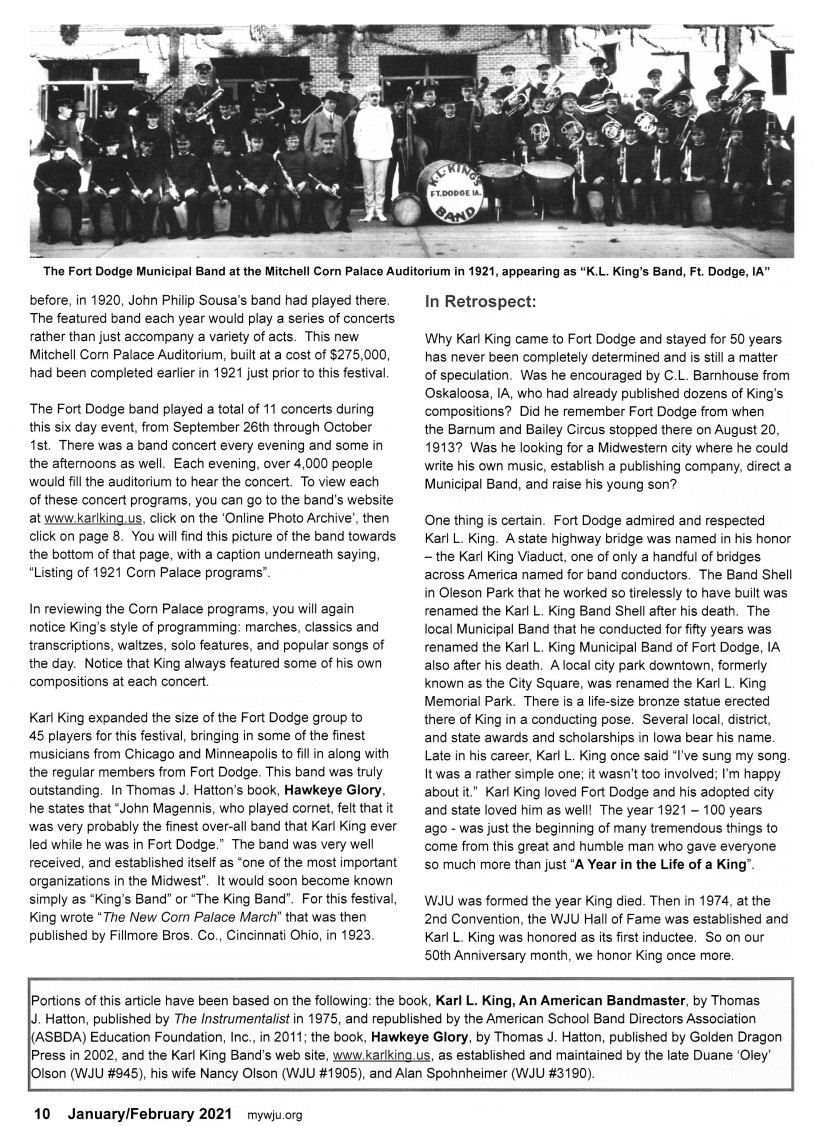
In Retrospect:
Why Karl King came to Fort Dodge
and stayed for 50 years has never been completely determined and is still
a matter of speculation. Was he encouraged by C.L. Barnhouse from
Oskaloosa IA, who had already published dozens of King’s compositions?
Did he remember Fort Dodge from when the Barnum and Bailey Circus stopped
there on August 20, 1913? Was he looking for a Midwestern city
where he could write his own music, establish a publishing company, direct
a Municipal Band, and raise his young son?
One thing is certain. Fort
Dodge admired and respected Karl L. King. A state highway bridge
was named in his honor in the 1960s – the Karl King Viaduct, one of only
a handful of bridges across America named for band conductors.
The Band Shell in Oleson Park that he worked so tirelessly to have built
in the 1930s was renamed the Karl L. King Band Shell after his death.
The local Municipal Band that he conducted for fifty years was renamed
the Karl L. King Municipal Band of Fort Dodge IA also after his death.
A local city park downtown, formerly known as the City Square, was renamed
the Karl L. King Memorial Park. There is a life-size bronze
statue erected there of King in a conducting pose. Several
local, district, and state awards and scholarships in Iowa bear his name.
Late in his career, Karl L. King
once said “I’ve sung my song. It was a rather simple one; it
wasn’t too involved; I’m happy about it.” Karl King loved
Fort Dodge, and his adopted city and state loved him as well!
The year 1921 – 100 years ago - was just the beginning of so many tremendous
things to come from this great and humble man who gave everyone so much
more than just “A Year in the Life of a King”.
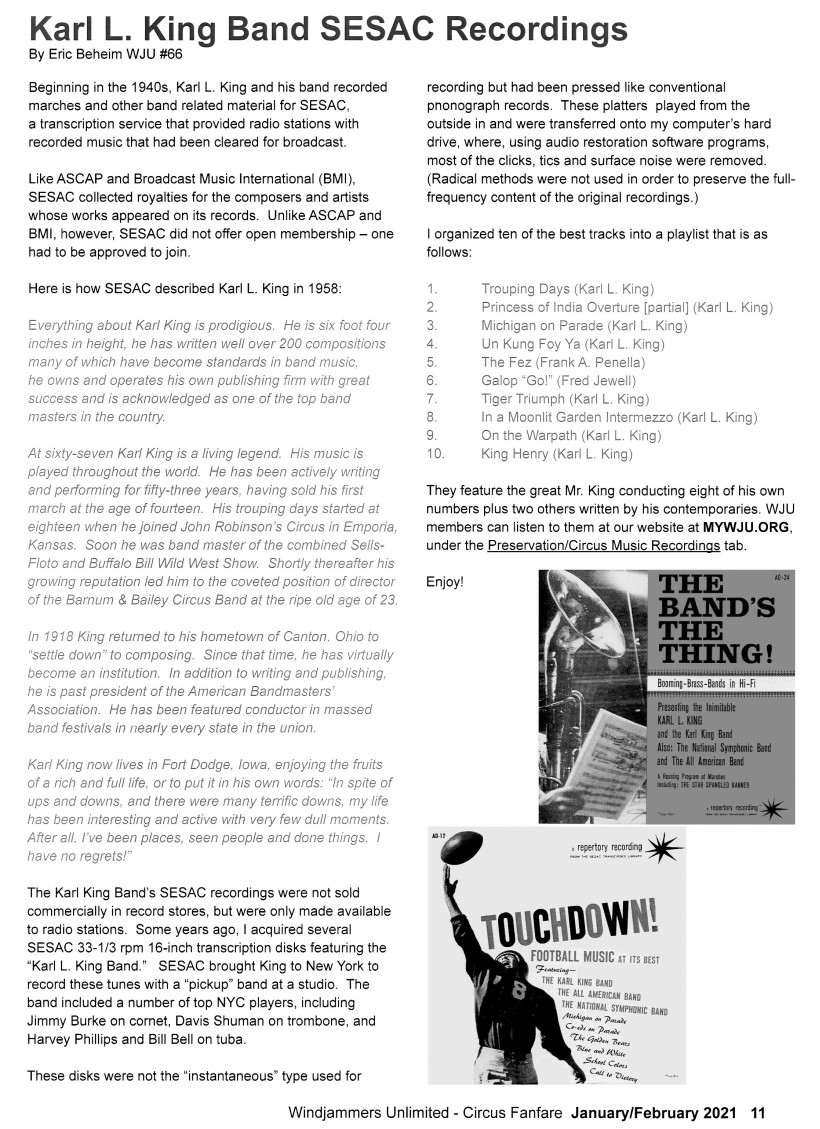
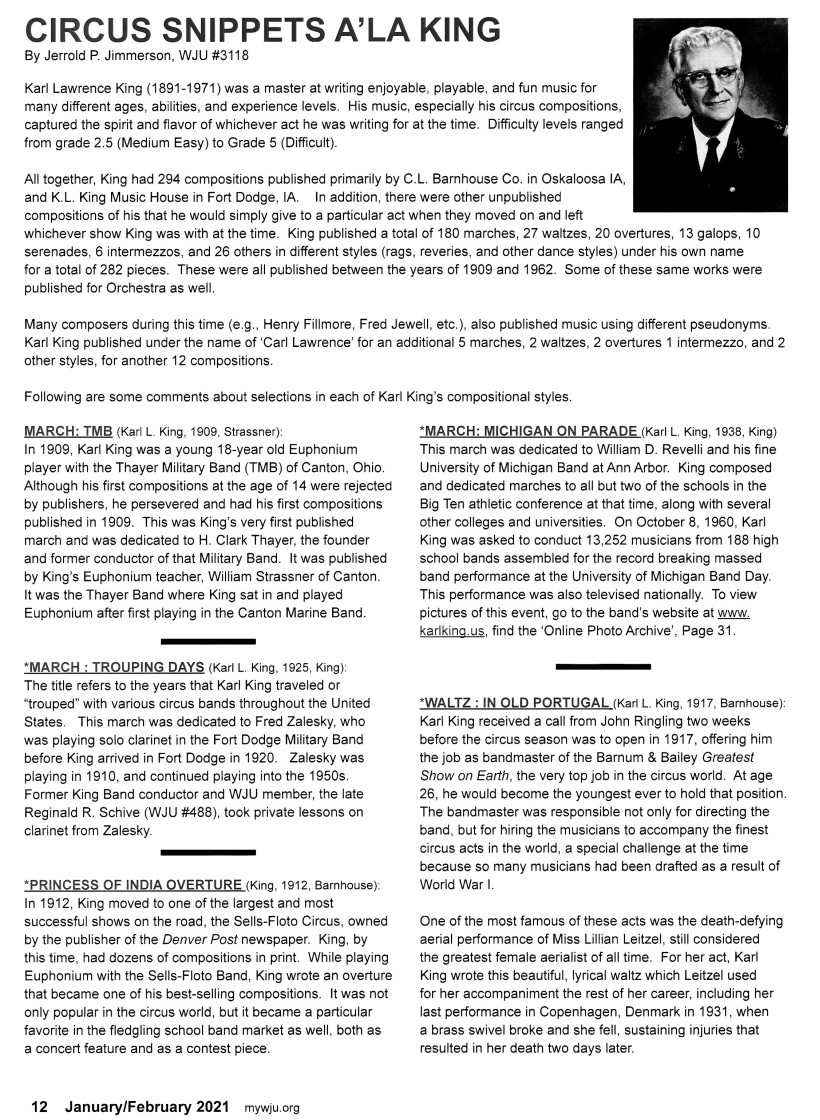
KARL KING COMPOSITIONS FOR BAND:
By Jerrold P. Jimmerson (WJU
#3118)
A portion of this article was
published in the January-February 2021 Circus Fanfare publication
of Windjammers Unlimited, Inc.: VOL. 51, NO. 1 - JAN/FEB 2021 - ISSN 1056-1463
Karl Lawrence King (1891-1971)
was a master at writing enjoyable, playable, and fun music for many different
ages, abilities, and experience levels. His music, especially
his circus compositions, captured the spirit and flavor of whichever act
he was writing for at the time. Difficulty levels of his music
ranged from grade 2.5 (Medium Easy) to Grade 5 (Difficult).
His music is playable with younger groups to high school groups and community
bands to college and professional bands.
Occasionally a question might
come up about how many compositions did King actually compose and publish.
Generally the estimate is ‘about 300’. The answer to the publishing
question is easier to determine; the answer to how many he actually composed
is a different matter.
All together, King had 294 compositions
published by a variety of companies, primarily C.L. Barnhouse Co. in Oskaloosa
IA, and K.L. King Music House in Fort Dodge IA. In addition,
there were other unpublished compositions of his that he would simply give
to a particular act when they moved on and left whichever circus show King
was with at the time. Other unpublished compositions were destroyed
in a disastrous fire in downtown Fort Dodge in 1971.
King published a total of 180
marches, 27 waltzes, 20 overtures, 13 galops, 10 serenades, 6 intermezzos,
and 26 others in different styles (rags, reveries, and other dance styles)
under his own name for a total of 282 pieces. These were all
published between the years of 1909 and 1962. Some of these
same works were published for Orchestra as well and are not included in
the final total here. He actually submitted some early composition
at age 14 (in 1905) which were rejected by the publishers.
Many composers during this time
(e.g., Henry Fillmore, Fred Jewell, etc.), also published music using different
pseudonyms. Karl King published under the name of ‘Carl Lawrence’
for an additional 5 marches, 2 waltzes, 2 overtures 1 intermezzo, and 2
other styles, for another 12 compositions.
In studying King’s compositional
output by decades, it is easy to determine where and when the majority
of his music was published. His first publications were in
1909, at the age of 18, when he had 9 published. These
included 5 marches, 2 waltzes, a serenade, and a dirge. His
first published march was “March T.M.B.”, dedicated to the Thayer Military
Band in Canton, Ohio. It was published by King’s Euphonium
teacher, William Strassner of Canton. It was the Thayer Band
where King sat in and played Euphonium after first playing in the Canton
Marine Band.
During the decade 1910-1919,
there were a total of 124 different compositions published, mostly in the
various circus styles. From 1920-1929, King published another
61 compositions. Several of these were dedicated to local members
of the Fort Dodge Municipal Band or others that he came in contact within
the city.
From 1930-1939, another 30 compositions
were published. Several of these were dedicated to colleges
and universities. In the 1940s, an additional 47 compositions
appeared, with several in two of his popular march books, Marching to Victory
in 1942 and Uncle Sam A-Strut in 1943.
In the 1950s, another 20 compositions
were published, with many of those included in his Liberty March Folio
in 1955. Finally in the early 1960s, his final 3 compositions
appeared. His final march publication was “The Home Town Boy”
in 1962, dedicated to Iowa’s own Meredith Willson of Mason City.
For more information on any of the publications by Karl L. King, you can
visit Karl King Compositions.
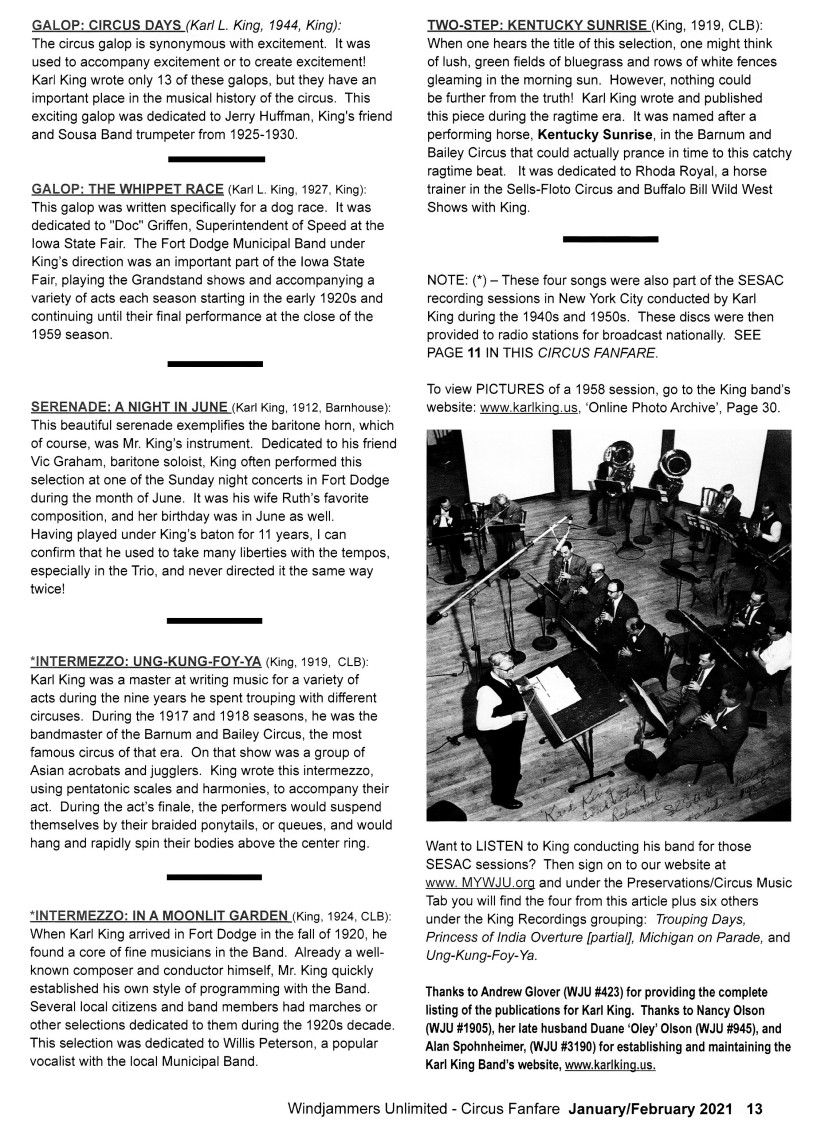
The next issue of the 2021 Circus Fanfare also
told about Karl L. King.
back to the Additional Resources Page
The Karl King Page






